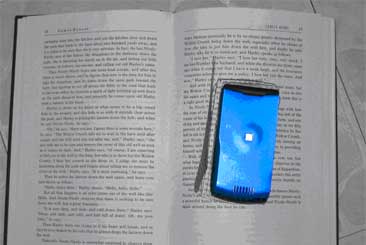 The following is an installment in "Icebreakers 101: The College Edition", a series featuring "Ice Breaker's" designed to promote training awareness and capabilities in the corrections industry.
The following is an installment in "Icebreakers 101: The College Edition", a series featuring "Ice Breaker's" designed to promote training awareness and capabilities in the corrections industry.
How are instructors like in-flight instructions and messages on the screen at a cinema? In class, we sometimes have to remind students to turn off their smart phones or personal devices so that there will be no interference. Of course, in the airplane, the signals are a potential hazard. In the cinema and the classroom, it is merely a matter of interruption.
Why not let students use the devices that they carry to help in the education process? Get them off Facebook and onto a problem that you pose.
Of course, if this is a classroom on grounds of a correctional facility, possession of a cell phone, especially inside the secure perimeter, is very likely to be a matter of possession of dangerous contraband. For this exercise, let us suppose that this is college classroom or a conference away from the facility. After all, we wish to educate, not facilitate a contraband crime.
This exercise can work only if students have personal devices with them. At this writing, the inexpensive nature, culture and ubiquity surrounding smart phones almost ensures that there will be at least two in the group.
- Ask students who have a smart phone on their person to raise their hands.
- Divide the class into two teams, making sure that there is at least one smart phone on each team.
- Remove one person from each team. These will be the observers
- Give each team a topic related to criminal justice. For example, assign Bernhard Goetz for one team and Carrie Nation for the other. These, as you know, are people who took the law into their own hands. Alcatraz and the nearest State prison serve as another example of topics.
- Tell each team that they must find five facts on the topic you assign.
- Tell students that they have to use their smart phones to find the five facts and present them to the class in five minutes.
- Have the observers look at who in each group handles the information from others. It may be a solo work or perhaps it is a team effort.
- Have each group present the five facts that they chose on their assigned topic to the entire class.
- Let observers describe to the class how the information dynamics worked in each group.
- Ask teams what sort of problems they encountered in this task.
- Give another topic to each team. Perhaps it could be probation for one team and parole for another. One could also give first degree murder to one team and vehicular manslaughter to the other. Tell the teams to organize themselves to efficiently find five facts about the topic in five minutes.
- Give the advice “Try for efficiency and good use of all team members.” Will there be a division of labor? Will one person record the facts? Will another select and present the facts or will it be a team of presenters? It is hoped that the teams learned from the observers’ comments.
- Let the fact finders find facts.
- Let the observers observe.
- Deconstruct the icebreaker as before.
- Discuss issues such as:
- Did teams note the differences between information on .com, .edu.gov and .org?
- Who is the fastest phone jockey?
- Who selected the information to be presented?
- What was the tone of the information? Was it shocking, factual, quirky, dry, or supported by citations?
- Did the students benefit from the advice of the observers?
- Who took charge?
The speed at which we access information is dizzying. Yet, we sometimes have to wade through so many bits of information and decide which is most pertinent and interesting. In the end, no matter the technology, interpersonal dynamics is what makes teams succeed or fail.
Personal technology in the hands of students does not have to be an enemy to the education process. Let the technology work for your lessons.
***********************************************************
Some topics for Five Facts from Phones:
- Prisons in the United States and prisons in Mexico
- Sentencing guidelines for possession of marijuana in Washington State and in Arkansas
- Death penalty by hanging and by firing squad
- Morrisey v. Brewer and Lewis v. Casey
- 14th Amendment and 8th Amendment
- Gun towers and security perimeter vehicles
- Community corrections and maximum security prisons
- Security classification and programs classification
- Escapes and assaults in prison
- Cognitive thinking programs and narcotics anonymous programs
Joe Bouchard is a Librarian employed with the Michigan Department of Corrections and a collaborator with The International Association of Correctional Training Personnel (IACTP). He is also the author of “IACTP’s Corrections Icebreakers: The Bouchard 101, 2014” and "Operation Icebreakers: Shooting for Excellence". The installments in this series include his opinions. The agency for which he works is not in any way responsible for the content or accuracy of this material, and the views are those of the contributor and not necessarily those of the agency. While some material is influenced by other works, all of the icebreakers have been developed by Joe Bouchard.
Visit the Joe Bouchard page
Other articles by Bouchard:
|
 The following is an installment in "Icebreakers 101: The College Edition", a series featuring "Ice Breaker's" designed to promote training awareness and capabilities in the corrections industry.
The following is an installment in "Icebreakers 101: The College Edition", a series featuring "Ice Breaker's" designed to promote training awareness and capabilities in the corrections industry.



Comments:
No comments have been posted for this article.
Login to let us know what you think